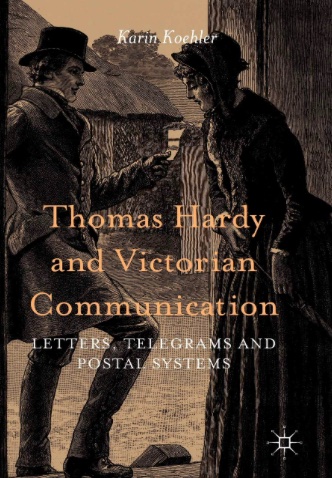[

Cover of the book under review. [Click to enlarge it.]
To say that textual artifacts have a life of their own in the work of Thomas Hardy is no doubt to state the obvious. For if textual inscriptions and the objects on which they are inscribed—valentines, letters, books of the Bible, even human bodies (in the case of William Dare's tattoo)—are anything at all, they are volatile. They move, often in dangerous and even deadly ways. Indeed, we need only recall Father Time's suicide note in Jude the Obscure in order to recognize the intimate, inextricable connection between the written word and death in Hardy's writing. As the epigraph to that novel reminds us from the outset, "the letter killeth" (43).
Focused as it is on the mobility of written communication, Karin Koehler's Thomas Hardy and Victorian Communication: Letters, Telegrams and Postal Systems promises to intervene in a crucial area of Hardy's work. Following an introduction that addresses the development of the penny post and Victorian communication systems more generally, Koehler covers an extensive range of Hardy's novels in six subsequent chapters. She reads the novels in relation to a range of critical issues, such as the tension between oral and written culture in Hardy's works; privacy and desire; "postal plots" (131) in the "novels of ingenuity"; and the connection between written communication and social marginalization in the tragedies of Jude the Obscure, The Woodlanders, and Tess of the d'Urbervilles. In connection to the latter, Koehler compellingly shows how Tess's various, wrenching moments of "epistolary failure" (157) serve to "undermin[e] the fiction of epistolary empowerment" (170) promised by the expansion of Victorian communication systems. This is followed by a chapter that addresses Hardy's short fiction and poetry, and a conclusion that wisely turns toward issues raised by Hardy's control of his own correspondence, his "epistolary reserve" (210).
One of the most significant aspects of Koehler's book is her treatment of the subject of privacy, in chapter 3. This issue is perhaps especially resonant for today's reader, as we continue to grapple with the increasingly fluid public/private divide when it comes to the expression of our words and intimate thoughts. Here, Koehler effectively observes that women's correspondence is frequently at the locus of suspicions and speculations regarding their sexual (im)purity. On the one hand, this should come as no surprise; we need only think back—as Koehler usefully does in her treatment of the rise and fall of epistolary fiction—to Richardson's Clarissa and Pamela to recall the persistent literary connection drawn between the female body and the textual artifact. Yet Koehler situates Hardy's innovative treatment of this connection in a way that convincingly reveals how "[t]he Victorians' intensified emphasis on privacy may be linked to changes in the social organization of eighteenth- and nineteenth-century Britain" (47). [End Page 310]
Detracting from the strength of the study is a matter that is a question of both editorial intervention and argument structure: the author's tendency toward overreliance on secondary criticism. Frequent, often lengthy quotations from other critics have a tendency to disrupt Koehler's sustained analysis. A similar need to reassure the reader emerges in the book's overall structure. The final full chapter, "Epistolary Ghosts," considers the "patterns, continuities, and shifts in [the] representation of written communication" (185) in the short story "On the Western Circuit" and a selection of poetry, including "Thoughts of Phena" and "The Torn Letter." While "An Imaginative Woman" would surely have made a perfect pairing to the book's discussion of "epistolary personae" (195), Koehler rightly points out that Hardy's shorter works are often compelling in their engagement with spectral presences in the very way that they "evoke letters by negation only" (196). Koehler does not claim to do justice here to all of Hardy's poetry, nor can she, and while I am grateful to see both poetry and short fiction given consideration, this chapter's position in the book makes it feel like an obligatory a!erthought, a necessity rather than an integral part of the overall argument.
This final chapter nonetheless points us back to those crucial issues that form the focus of this study and, indeed, so much of Hardy's work: the emphasis on miscommunication and the very elusive quality of his characters, whether embodied physically or conveyed textually. In this regard, Koehler's Thomas Hardy and Victorian Communication reminds us why we continue to read Hardy and why his work remains so vital. As Koehler writes, "he never ceased to be preoccupied by the question of what prevents people from recognition of one another's subjectivity, and from forming relationships based on genuine perception of one another's nature, needs, and desires" (187).
Links to Related Material
- The Private Letter as Plot Device in The Mayor of Casterbridge
- Letter Writing in Victorian Literature
- The Victorian Revolution in Letter Writing
- The Genres of Victorian Letter Writing
- Victorian Telecommunications
Bibliography
[book under review] Koehler, Karen. Thomas Hardy and Victorian Communication: Letters, Telegrams and Postal Systems. Palgrave Macmillan, 2016.
Hardy, Thomas. Jude the Obscure. Edited by Cedric Watts, Broadview, 1999.
Created 19 March 2024